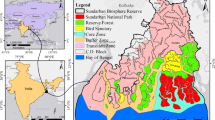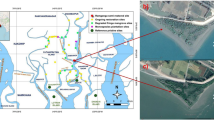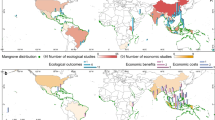Abstract
Indonesia, the most mangrove-rich nation in the world, has proposed the most globally ambitious mangrove rehabilitation target (600,000 ha) of any nation, to be achieved by 2024 to support multiple Sustainable Development Goals (SDG 1–3, 6, 13 and 14). Yet, mangrove restoration and rehabilitation across the world have often suffered low success rates and been applied at small scales. Here, we identify 193,367 ha (estimated costs at US$0.29–1.74 billion) that have the potential to align with the national mangrove rehabilitation programme. Despite being only 30% of the national target, our robust assessment considered biogeomorphology, 20 years of land-use and land-cover change and state forest land status, all key factors moderating mangrove restoration success which have often been neglected in Indonesia. Increasing subnational government representation in mangrove governance as well as improving monitoring and evaluation will increase the likelihood of achieving the mangrove rehabilitation targets and reduce risks of failure. Rehabilitating and conserving mangroves in Indonesia could benefit 74 million coastal people and can potentially contribute to the national land-sector emissions reduction of up to 16%.
This is a preview of subscription content, access via your institution
Access options
Access Nature and 54 other Nature Portfolio journals
Get Nature+, our best-value online-access subscription
$32.99 / 30 days
cancel any time
Subscribe to this journal
Receive 12 digital issues and online access to articles
$119.00 per year
only $9.92 per issue
Buy this article
- Purchase on SpringerLink
- Instant access to full article PDF
Prices may be subject to local taxes which are calculated during checkout




Similar content being viewed by others
Data availability
All data are available in the main text or the Supplementary Information. Results data from this study on mangrove restoration potential area by region in Indonesia can be accessed through the following figshare repository link: https://doi.org/10.6084/m9.figshare.19636458. The generated spatial results data on mangrove restoration potential area in Indonesia can be directly accessed in Google Earth Engine using the following asset ID: projects/ee-mangroverestoration/assets/Indo_mangrove_restore.
References
Giri, C. et al. Status and distribution of mangrove forests of the world using Earth observation satellite data: status and distributions of global mangroves. Glob. Ecol. Biogeogr. 20, 154–159 (2011).
Ilman, M., Dargusch, P., Dart, P. & Onrizal A historical analysis of the drivers of loss and degradation of Indonesia’s mangroves. Land Use Policy 54, 448–459 (2016).
Spalding, M. D. & Leal, M. (eds) The State of World’s Mangroves 2021 (Global Mangrove Alliance, 2021).
Badan Restorasi Gambut dan Mangrove (Government of Indonesia, 2020).
Indonesia Mangroves for Coastal Resilience Project (World Bank, 2021).
Lee, S. Y., Hamilton, S., Barbier, E. B., Primavera, J. & Lewis, R. R. Better restoration policies are needed to conserve mangrove ecosystems. Nat. Ecol. Evol. 3, 870–872 (2019).
Lovelock, C. E. & Brown, B. M. Land tenure considerations are key to successful mangrove restoration. Nat. Ecol. Evol. 3, 1135–1135 (2019).
Bayraktarov, E. et al. The cost and feasibility of marine coastal restoration. Ecol. Appl 26, 1055–1074 (2016).
Global Mangrove Alliance Roadmap 2021 (Global Mangrove Alliance, 2021); https://www.mangrovealliance.org/wp-content/uploads/2021/07/Global-Mangrove-Alliance-Roadmap-2021.pdf
Adame, M. F. et al. Future carbon emissions from global mangrove forest loss. Glob. Change Biol. 27, 2856–2866 (2021).
Friedlingstein, P. et al. Global carbon budget 2020. Earth Syst. Sci. Data 12, 3269–3340 (2020).
Goldberg, L., Lagomasino, D., Thomas, N. & Fatoyinbo, T. Global declines in human‐driven mangrove loss. Glob. Change Biol. 26, 5844–5855 (2020).
Lovelock, C. E. et al. The vulnerability of Indo-Pacific mangrove forests to sea-level rise. Nature 526, 559–563 (2015).
Hooijer, A. & Vernimmen, R. Global LiDAR land elevation data reveal greatest sea-level rise vulnerability in the tropics. Nat. Commun. 12, 3592 (2021).
Lewis, R. R. Ecological engineering for successful management and restoration of mangrove forests. Ecol. Eng. 24, 403–418 (2005).
Brown, B., Fadillah, R., Nurdin, Y., Soulsby, I. & Ahmad, R. Community based ecological mangrove rehabilitation (CBEMR) in Indonesia. Sapiens 7.2 (2014).
Buku III Himpunan Rkakl Ta 2022 (Government of Indonesia, 2021).
Mangrove Conservation and Restoration: Protecting Indonesia’s “Climate Guardians” (World Bank, 2021); https://www.worldbank.org/en/news/feature/2021/07/26/mangrove-conservation-and-restoration-protecting-indonesia-climate-guardians
Kusmana, C. Lesson learned from mangrove rehabilitation program in Indonesia. J. Pengelolaan Sumberd. Alam Lingkung. 7, 89–97 (2017).
Sidik, F., Adame, M. F. & Lovelock, C. E. Carbon sequestration and fluxes of restored mangroves in abandoned aquaculture ponds. J. Indian Ocean Reg. 15, 177–192 (2019).
Goessens, A. et al. Is Matang mangrove forest in Malaysia sustainably rejuvenating after more than a century of conservation and harvesting management? PLoS ONE 9, e105069 (2014).
Salmo, S. G. in Dynamic Sedimentary Environments of Mangrove Coasts (eds Sidik, F. & Friess, D. A.) 539–562 (Elsevier, 2021).
Nguyen, T. P., Luom, T. T. & Parnell, K. E. Mangrove transplantation in Brebes Regency, Indonesia: lessons and recommendations. Ocean Coast. Manag. 149, 12–21 (2017).
Wibisono, I. T. C. & Suryadiputra, I. N. Study of Lessons Learned from Mangrove/Coastal Ecosystem Restoration Efforts in Aceh since the Tsunami (Wetlands International, 2006); http://www.wetlands.or.id/PDF/buku/Lessons%20Learned%20in%20Aceh%20by%20WIIP.pdf
Cameron, C., Hutley, L. B., Friess, D. A. & Brown, B. Community structure dynamics and carbon stock change of rehabilitated mangrove forests in Sulawesi, Indonesia. Ecol. Appl. 29, e01810 (2019).
Danielsen, F. The Asian tsunami: a protective role for coastal vegetation. Science 310, 643–643 (2005).
McCARTHY, M. A. & Possingham, H. P. Active adaptive management for conservation. Conserv. Biol. 21, 956–963 (2007).
Strategi Nasional Pengelolaan Ekosistem Mangrove (Government of Indonesia, 2012).
Peraturan Menteri Koordinator Bidang Perekonomian (Coordinating Ministry of Economy, 2017).
Updated Nationally Determined Contribution Republic of Indonesia (Government of Indonesia, 2021).
Wibowo, K. Pelestarian hutan mangrove melalui pendekatan mina hutan (silvofishery). J. Teknol. Lingkung. 7, 227–233 (2006).
Fitzgerald, W. J. in Ecological Aquaculture–the Evolution and the Blue Revolution (ed. Costa-Pierce, B. A.) 161–262 (Blackwell Science, 2002).
Hansen, M. C. et al. High-resolution global maps of 21st-century forest cover change. Science 342, 850–853 (2013).
Worthington, T. A. et al. A global biophysical typology of mangroves and its relevance for ecosystem structure and deforestation. Sci. Rep. 10, 14652 (2020).
Peta Kawasan Hutan (Ministry of Environment and Forestry, 2021); http://dbgis.menlhk.go.id/arcgis/rest/services/KLHK/Kawasan_Hutan/MapServer
Jumlah Penduduk Hasil SP menurut Wilayah dan Jenis Kelamin, Indonesia 2020 (Badan Pusat Statistik, 2020); https://sensus.bps.go.id/topik/tabular/sp2020/83
Richards, D. R. & Friess, D. A. Rates and drivers of mangrove deforestation in Southeast Asia, 2000–2012. Proc. Natl Acad. Sci. USA 113, 344–349 (2016).
Eddy, S., Milantara, N., Sasmito, S. D., Kajita, T. & Basyuni, M. Anthropogenic drivers of mangrove loss and associated carbon emissions in South Sumatra, Indonesia. Forests 12, 187 (2021).
Murdiyarso, D. et al. The potential of Indonesian mangrove forests for global climate change mitigation. Nat. Clim. Change 5, 1089–1092 (2015).
Sasmito, S. D. et al. Mangrove blue carbon stocks and dynamics are controlled by hydrogeomorphic settings and land-use change. Glob. Change Biol. 26, 3028–3039 (2020).
Murdiyarso, D., Sasmito, S. D., Sillanpää, M., MacKenzie, R. & Gaveau, D. Mangrove selective logging sustains biomass carbon recovery, soil carbon, and sediment. Sci. Rep. 11, 12325 (2021).
Sasmito, S. D. et al. Effect of land-use and land-cover change on mangrove blue carbon: a systematic review. Glob. Change Biol. 25, 4291–4302 (2019).
SER International Primer on Ecological Restoration (Society for Ecological Restoration, 2004).
Acknowledgements
This work was funded by the Ministry of Education and Culture Republic of Indonesia under the World Class University Program of Universitas Sumatera Utara Year 2020 (grant no. 1879/UN5.1.R/SK/PPM/2020). This study was part of the Newton Fund project MOMENTS and supported by a research grant from the Indonesian Science Fund and Indonesia Endowment Fund for Education (DIPI/LPDP grant no. NE/P014127.1) and National Geographic Society Research and Exploration grant (NGS-68810R-20). S.D.S. was supported by NERI Integrated Tropical Peatlands Research Programme (R-706-000-062-720). D.M. was supported by the United States Agency for International Development grant no. MTO 069033.
Author information
Authors and Affiliations
Contributions
Conceptualization of this work was by S.D.S. and M.B. The methodology was developed by S.D.S., M.B., A.K. and M.F.S. Investigations were undertaken by S.D.S., M.B., A.K., M.F.S., C.E.L. and D.M. Visualization was by S.D.S. and A.K. Funding was obtained by S.D.S. and M.B. The project was administered by S.D.S. and M.B. with supervision by C.E.L. and D.M. The original draft was written by S.D.S. and M.B. who, along with A.K., M.F.S., C.E.L. and D.M., were involved in reviewing and editing the final manuscript.
Corresponding authors
Ethics declarations
Competing interests
The authors declare no competing interests.
Peer review
Peer review information
Nature Ecology & Evolution thanks Liza Goldberg, Mark Huxham, Lisa Schindler Murray and the other, anonymous, reviewer(s) for their contribution to the peer review of this work. Peer reviewer reports are available.
Additional information
Publisher’s note Springer Nature remains neutral with regard to jurisdictional claims in published maps and institutional affiliations.
Extended data
Extended Data Fig. 1 Key mangrove management and conservation policies in Indonesia and relevant international environmental agenda between 1990 and 2030.
A further detailed list of mangrove management policies in Indonesia is described in Supplementary Table 1.
Extended Data Fig. 2 Mangrove restoration opportunity scenarios according to their loss drivers or the latest land use types, namely erosion, commodities, settlement, non-productive conversion, climate event and deforested mangrove.
a, national distribution of restoration opportunity scenarios at 1 degree grid, b, selected grids of restoration opportunity scenarios distribution in South Sumatra, Riau, North Kalimantan, East Kalimantan, and West Kalimantan province, c, the proportion and area of restoration opportunity scenarios across all provinces in Indonesia according to loss drivers documented by Goldberg et al.12 (see methods section for detailed description how this study overlaid loss drivers data with tree cover loss data by Hansen et al.33). Mangrove loss drivers such as erosion, settlement, and climate event were considered of having a low restoration opportunity scenario, while other drivers including commodities and non-productive conversion were a medium scenario. The high restoration opportunity scenario was only considered in areas where mangroves are deforested (living biomass is removed with minimal soil and hydrological disturbance). Further description of the scenarios classification for each loss driver is provided in Supplementary Table 4.
Extended Data Fig. 3 Mangrove restoration opportunity scenarios according to their forest land status in Indonesia, namely other land use allocation, production and protected forests.
a, national distribution of restoration opportunity scenarios at 1 degree grid, b, selected grids of restoration opportunity scenarios distribution in South Sumatra, Riau, North Kalimantan, East Kalimantan, and West Kalimantan province, c, the proportion and area of restoration opportunity scenarios across all provinces in Indonesia according to the national standard for land status by Ministry of Environment and Forestry35. A low opportunity scenario was given to areas belonging to other land use allocations (area penggunaan lain or APL), where this specific land status is commonly associated with private land ownership. Medium and high restoration opportunity scenarios were respectively assigned to areas under production forest (hutan produksi) and protected forest (hutan lindung) designations. Further description of the scenarios classification for each loss driver is provided in Supplementary Table 4.
Extended Data Fig. 4 Mangrove restoration opportunity scenarios according to multiple biogeomorphological settings.
The mangrove typologies included in this study are delta-terrigenous, estuary-terrigenous, open coast-carbonate, open coast-terrigenous, and others (an area that does not belong to any settings described by Worthington et al.34). a, national distribution of restoration opportunity scenarios at 1 degree grid, b, selected grids of restoration opportunity scenarios distribution in South Sumatra, Riau, North Kalimantan, East Kalimantan, and West Kalimantan province, c, the proportion and area of restoration opportunity scenarios across all provinces in Indonesia according to biogeomorphological typology. The low scenario was assigned to areas located in both open coast-carbonate and open coast-terrigenous settings. A medium scenario was given to areas located in delta-terrigenous and other settings. Estuary-terrigenous was the only setting with a high restoration opportunity scenario. Further description of the scenarios classification for each loss driver is provided in Supplementary Table 4.
Supplementary information
Supplementary Information
Supplementary Figs. 1 and 2 and Tables 1–14.
Rights and permissions
Springer Nature or its licensor (e.g. a society or other partner) holds exclusive rights to this article under a publishing agreement with the author(s) or other rightsholder(s); author self-archiving of the accepted manuscript version of this article is solely governed by the terms of such publishing agreement and applicable law.
About this article
Cite this article
Sasmito, S.D., Basyuni, M., Kridalaksana, A. et al. Challenges and opportunities for achieving Sustainable Development Goals through restoration of Indonesia’s mangroves. Nat Ecol Evol 7, 62–70 (2023). https://doi.org/10.1038/s41559-022-01926-5
Received:
Accepted:
Published:
Issue date:
DOI: https://doi.org/10.1038/s41559-022-01926-5
This article is cited by
-
Ambitions in national plans do not yet match bold international protection and restoration commitments
Nature Ecology & Evolution (2025)
-
Strategic mangrove restoration increases carbon stock capacity
Communications Earth & Environment (2025)
-
Half of land use carbon emissions in Southeast Asia can be mitigated through peat swamp forest and mangrove conservation and restoration
Nature Communications (2025)
-
Land use change and mangrove conservation strategies in the Gulf of Guayaquil Ecuador through spatial and delphi based analysis
Discover Applied Sciences (2025)
-
Generative language models potential for requirement engineering applications: insights into current strengths and limitations
Complex & Intelligent Systems (2025)



